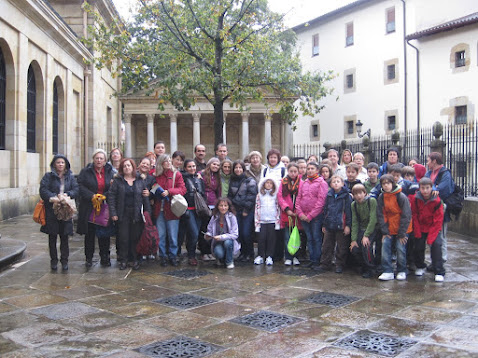We have already started to map our tour. To start with, we devided the work so that all the groups could take part: the oldest ones will trace the route on a map, learn about how to draw a profile and describe the whole valley; all the rest will investigate and write a comment on the different stops we´ll make, the interesting places we will visit and the past and present of those places of historical, social or natural interest.
One of the places included in our tour is an old house that was used as a smithy for many years and then became a water mill after a time. 1st and 2nd graders are working on that stop at the moment. This spot is a good chance to learn about former jobs. They visited the place on Wednesday. Then, on Friday, a German friend- Basque speaker- came to school and explained to the students how a mill works. They also wrote the names of different cereals in Basque, Spanish, English and German, grinded some rye, calculated how much weigh was lost and at last ate some rye bread. They also learnt that rye is not grown in the Basque Country. The cereal that was commonly used here was corn.






They also visited a water mill that is still used to produce flour. They listened to the explanations and had fun.
After learning about a miller´s wok, they learnt about blacksmiths. In former times there were a lot of smithies along Zeberio river, that is why there are a lot of places in the village that have names related to that. Students had the chance to examine iron as a mineral; to know where iron and wood- for the forge-were taken from in our forests and see how a smithy used to work and what kind of pruducts blacksmiths made.

4th class is working on another stop: the Townhall. They visited the Townhall on Monday. They learnt some interesting facts about the building itself, the work done there and also saw one of the oldest archives still kept in the Basque Country and many other European villages with documents that date back from the 16th century.

Class 5 is working on the Royal Way that crosses the whole village and used to be the main route to go from a village to another and for trade. They are also learning about one of the most important churches we have: Olabarrietako Santo Tomas. A parent came to school and taught the children many important and amazing things about these topics.

Ater the explanations they went on a fieldtrip to see and take pictures of all the places.

In the pictures below, you can see the oldest students. They are working with a map of the village. Their aim now is to draw the profile of our route so their first step is to learn about contour lines: what they represent and how to calculate the altitude of a place by reading those lines. Really interesting!!!


The smallest students walked along Sautuolabarri , the area where our school is located. They looked at the bulidings, the natural places, they talked to the people and they took some photographs so they can start writing their description of the place.
After their fieldtrip, these children have already started to write about the walk: the route they followed, the houses they saw,...They have also made their own map about the area. Have a look at it!
Some more news about our route. 3rd class visited one of the three sawmills in Zeberio. There, students learnt how a sawmill works, the kind of trees they use and why we have so many pinetree plantations in the village. They also learnt that in former times there weren´t so many pinetrees but beechwoods because beeches were used to make coal for the smithies.















































